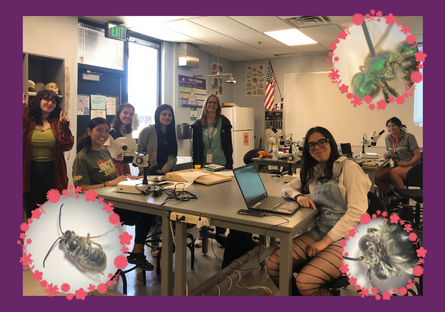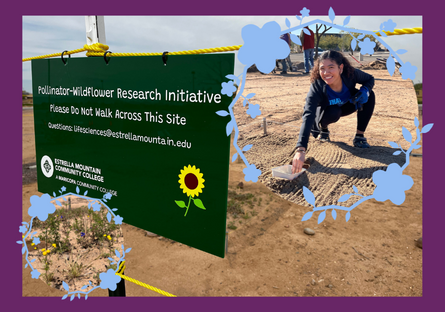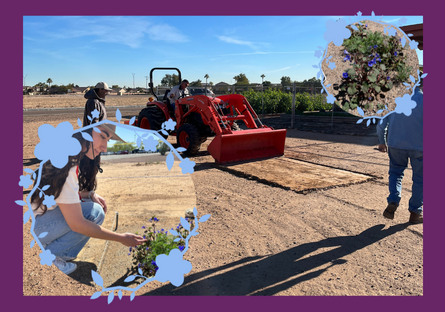


Undergrads Study Wildflower Growth; Conduct Native Bee Survey
Estrella Mountain Community College (EMCC) STEM students are busy, busy bees having engaged in Undergraduate Research Experiences, or UREs this semester. Some of our Mountain Lions just wrapped up a study of wildflower growth across different soil types while others are conducting a native bee survey — two things that can’t live without the other.
The wildflower study started last fall when Quail Forever, a wildlife habitat conservation group, donated a rather large sum of wildflower seeds to EMCC Biology Professor Dr. Catherine Parmiter to use in her classes. They couldn’t have come at a better time as her colleague, Professor Thasanee Morrissey, who also teaches biology and is the Program Analyst for the STEM Center, just happened to be looking for a research opportunity for her students.
They decided to create a URE for five of their students and the Pollinator-Wildflower Research Initiative was born. The goal of the initiative was to determine which type of soil wildflowers would grow best in, with the understanding that more healthy wildflowers attract pollinators such as bees.
First, with the help of their Life Sciences Division colleagues Drs. Neil Raymond, Rachel Smith, and Jarod Raithel, along with the Facilities Department, an area was cleared next to the EMCC Community Teaching Garden where they constructed 16 research plots with four different soil types — native soil, pea gravel, compost, and sand. Next, they asked the MakerSpace to create some appealing signage to mark off the area. Then they planted nine different varieties of wildflower seeds and turned on the irrigation. After that, they monitored the plots weekly and kept track of the plants’ growth with written observations and digitized images.
Natalia Quinones, one of Dr. Parmiter’s students who is graduating this spring with an Associate in Biological Sciences and then transferring to Arizona State University (ASU) to study microbiology, said one of the reasons she signed up for the URE was to boost her resume.
“I hope that this experience will allow me to join other research projects when I transfer to ASU,” she said.
Dr. Parmiter said the selection process for research opportunities at the university level is very competitive.
“Gaining research experience at the pre-Associate Degree level is essential for students such as Natalia as she navigates her transfer to ASU and later to medical school,” Dr. Parmiter said.
For this URE, Natalia and her lab partner were responsible for identifying the types of flowers in each substrate of soil and measuring the nitrogen, phosphorus, potassium, and pH content in each plot.
“I learned more about plant growth and development,” Natalia said. “I gained more knowledge and new vocabulary about the subject. And I learned how to edit and rewrite procedures.”
Dr. Parmiter said Natalia’s field observations and attention to detail were an asset to the team.
“She is an excellent student researcher,” Dr. Parmiter said.
Natalia also works as a part-time lab technician in EMCC’s Life Science Lab, another gold star on her resume.
“I started as a student worker in September 2022 and the lab technicians were always patient and allowed me to make mistakes and learn from them,” she said. “And since they knew I wanted to pursue an education in microbiology, they educated and taught me skills that would apply to my field of study.”
Students who participated in the Pollinator-Wildflower Research Initiative will earn Western Alliance to Expand Student Opportunities (WAESO) scholarships after they submit their research summaries.
“This scholarship is encouragement for all of the hard work that has gone into this project,” Natalia said. “It also shows that the school supports undergraduate students to work outside the classroom and gain hands-on experiences.”
Cierra Herrera, one of Professor Morrisey’s students who participated in the Pollinator-Wildflower Research Initiative, is also big on hands-on experiences.
“I learn best when I am doing, and I learned a lot,” Cierra said. “I love to learn and put that knowledge into practice and that is exactly what UREs do.”
Cierra, who is also one of EMCC’s Animal Ambassadors, will graduate this spring and then transfer to the University of Hawaiʻi at Mānoa. She plans to double major in Animal Science and either Plant and Environmental Protection Services or Marine Biology.
“I’ve always been caring and conserving before I even knew what that meant,” she said. As unusual as it might sound for a 10-year-old, I hated wasting paper, always recycled, loathed littering, and it always hurt me to see animals suffering, especially because of us, and when we can do something about it. As I continued to go to school and learned more about biology, endangered species, and why they are being endangered, there was no doubt in my mind that I wanted to help these animals.”
Naturally, when Cierra heard about the native bee survey URE, she signed up for that one, too. A perfect complement to the Pollinator-Wildflower Research Initiative, the EMCC Native Bee Project officially kicked off in March. It’s part of a collaborative effort with community colleges in Arizona and California conducting surveys to find out how many different types of bees exist across the two states, something that is currently unknown.
“One out of every three bites of your food you owe to bees,” Dr. Raithel said. “We don’t even have a baseline to know how many bees we have. They are crucial to our survival, yet we know so little about them.”
The EMCC Native Bee Project began over spring break with Drs. Parmiter, Raithel, and Smith spending four days at the College of the Canyons in Santa Clarita, Calif., learning how to identify, or “key,” native bees so that they could pass that knowledge on to their URE students. Since then, they have begun teaching their students how to catch, clean, dry, pin, key, and photograph native bees caught on and around campus. It’s a lengthy and sometimes nerve-racking process, but for Cierra, the keys are the bee’s knees.
“Looking at the bee under the microscope is my favorite part,” she said. “They are majestic creatures and so beautiful. It is crazy to see the variation of bees in our lab! They are all so unique.”
The National Science Foundation-funded native bee URE will last three years with six students participating each semester. The data collected will be verified and entered into Symbiota, a public database, and each bee will have an identification number that corresponds to the student who keyed it.
“It is mind-blowing just thinking about the fact that a native bee that I, myself, keyed will go into a national database with my name!” Cierra said. “That’s absolutely surreal to me, but it is really happening. It makes me a little emotional just thinking about it because I see it as a big deal and I’m only 20 years old and this is happening along with my fellow peers. I can only think about my future and what it has in store for me.”
Cierra’s professors describe her as a problem solver who never hesitates to roll up her sleeves and dive into the action.
“She was like our wildflower research group’s secret weapon — always diving fearlessly into problems and asking all the right questions,” Professor Morrisey said. “With her sharp critical thinking skills, she was like the Sherlock Holmes of our research team! But what’s even better is her team spirit — she’s the ultimate collaborator, bringing fresh ideas to the table.”
Professor Morrisey’s students wrapped up their wildflower growth URE and presented their findings at the Arizona-Nevada Academy of Science Annual Meeting on April 13 at Glendale Community College.
“They did great and had a great experience at their first science conference,” Professor Morrisey said.
Cierra said she was nervous but ultimately enjoyed herself.
“It was really good!” she said. “One of the judges said our poster was eye-catching and easy to follow. He was really happy with our experiment in the design aspect — how we eliminated a lot of bias, controlled all of our variables well, and the quadrat sampling. It was really rewarding to hear that feedback.”
Are you an Estrella Mountain Community College student who would like to join the EMCC Native Bee Project or any other STEM Undergraduate Research Experience? Email Dr. Catherine Parmiter at catherine.parmiter@estrellamountain.edu.